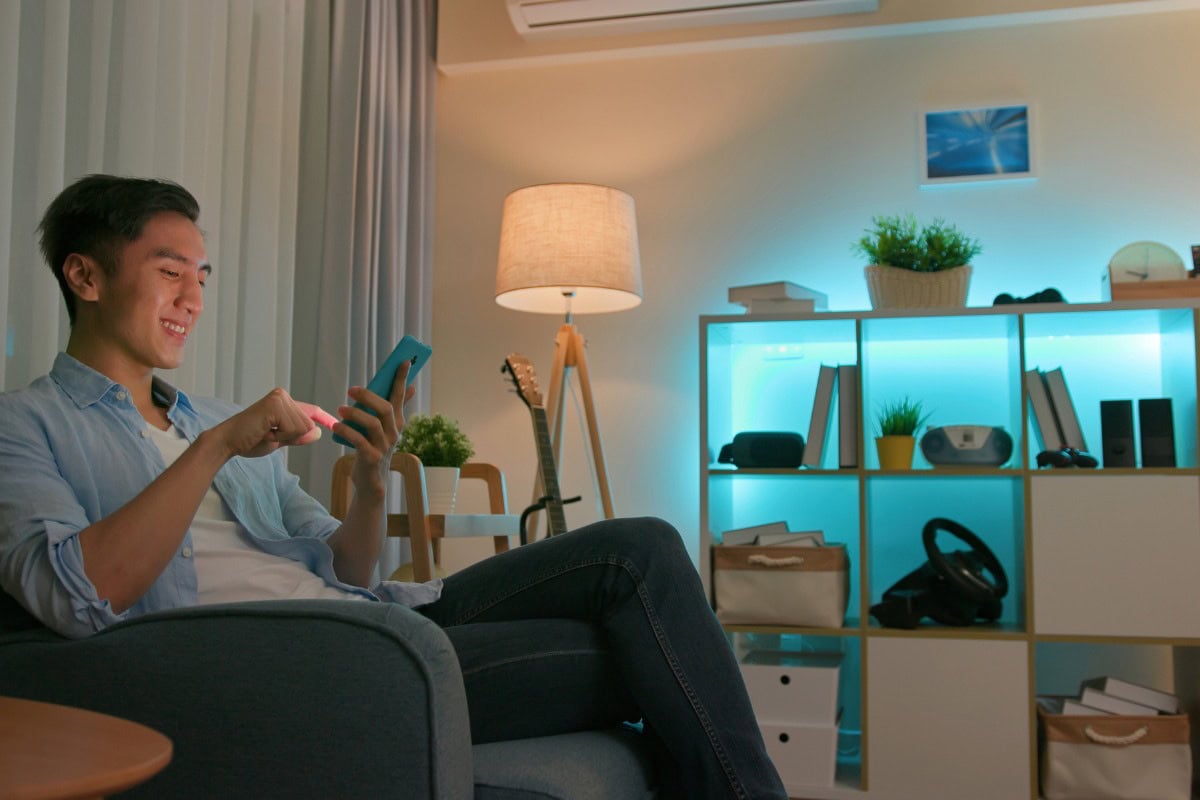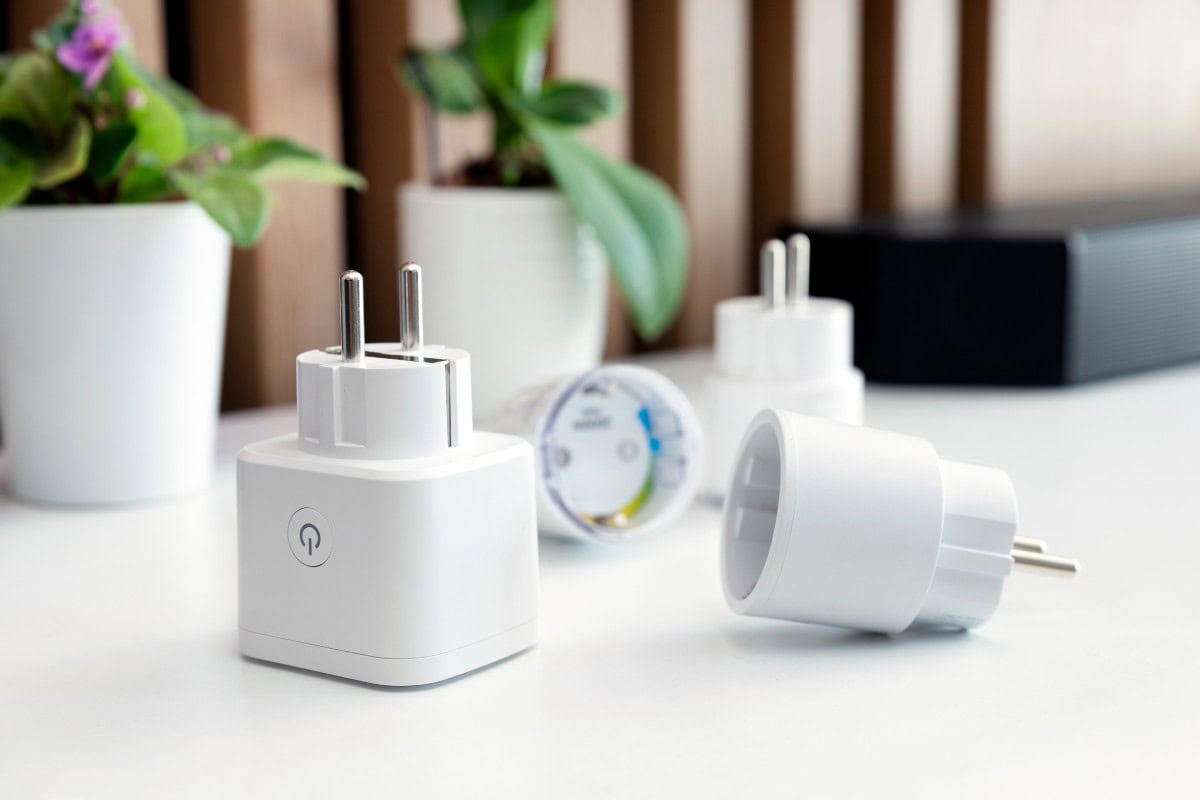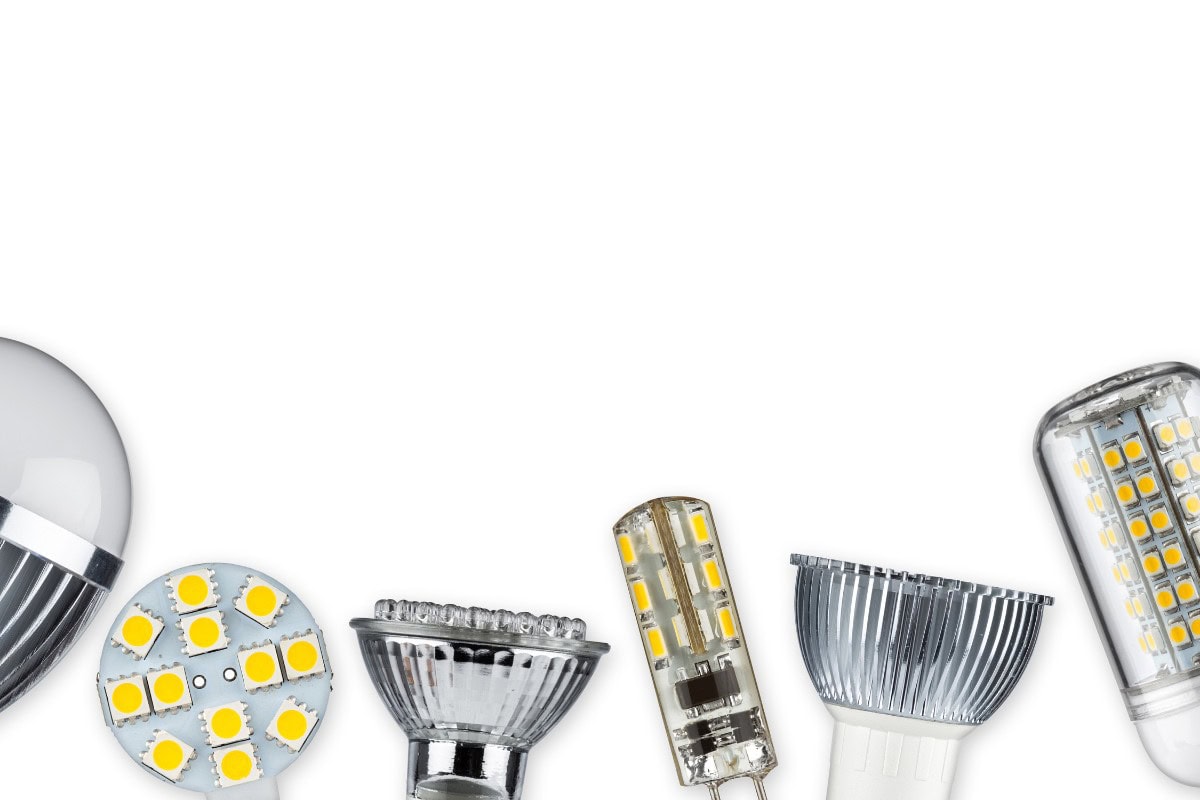Now that LED lighting technology has become widely available and affordable and a consumer level, the idea of smart lighting isn’t confined to sci-fi movies or the mansions of the ultra-rich anymore.
For those who aren’t entirely clear on the term, “smart lighting” refers to the ability to control every aspect of your home’s lighting remotely – typically from an app on your smartphone or through voice controls issued to Siri, Google Assistant, Alexa, etc.
You can raise or lower brightness, switch among different colors, set timers, and even pre-program different “moods” for various activities. Really, when you stand in a room that is fully outfitted with smart lighting technology, you can watch that same room look and feel completely different with each preset “lighting recipe.” No redecorating required.
So, to take a look at what smart lighting is, what it can do, how to budget for it, and what pitfalls to avoid, continue reading this complete guide. We are going to dive right in and sort this all out for you.
How Smart Lighting Works
Outfitting your home with a smart lighting set-up requires considerably more planning than simply filling a shopping cart with LED bulbs and downloading an app. However, it is important to note that consumer feedback has been helping companies to streamline their systems, meaning smart lighting is getting easier to use as time goes on.
In order to facilitate communication between your device and the various light bulbs in your home, you need to establish a specific network for your lighting system, and that begins with a hub. With some systems, such as the Hue or Lightify systems, the hub plugs right into your router. With other systems, such as LIFX, the platform connects wirelessly. So when you are making your selection, make sure that everything you choose is compatible, from the hub, to the bulbs, to your smartphone or tablet, and to your voice commands.
For an even greater level of control over your lighting environment, you may want to look into dimmer switches and motion detectors. These can also be incorporated into your smart lighting network and, in some cases, can even be blended with the IFTTT (If This, Then That) app.
IFTTT programming is one of the more exciting aspects of smart lighting and certainly the most futuristic. This system allows you to pre-program light recipes that will trigger automatically in certain situations. For instance, if you receive a notification on your phone, perhaps a colored light in your living room flashes once to let you know. Or perhaps a similar flash or glow could notify you that your exterior motion detectors have been triggered. With a fully connected smart lighting system, the IFTTT app can add a lot of utility without much difficulty for the user.
Now, let’s take a look at some more smart lighting capabilities.
What Smart Lighting Can Do
The following aspects of smart lighting are what make the technology so attractive to modern homeowners.
Remote Control
A smart lighting setup gives the user complete control over all of the lights in their home (or, at least, all of the lights that are hooked up to the smart lighting system) from a single device. Not sure if you left the basement light on? You can now not only check the answer to that question right on your phone or tablet, but you can also turn it off from wherever you happen to be. Additionally, some smart lighting systems also allow users to interact with the platform when they are away from home. This can help keep your electricity bills low, enhance safety, and deter theft.
Voice Control
Some smart lighting hubs can sync with Amazon’s Alexa, Google Home/Assistant, or Apple’s Siri to accept voice commands. Imagine telling your living room to prepare for movie watching or book reading and seeing the lightscape in your room change accordingly. Just be sure to confirm that the lighting system you are considering is compatible with the voice command system you currently use.
Schedule
Want to make sure nobody leaves a light burning in the kitchen all night? Hate walking into a completely dark house upon arriving home? Scheduling features allow you to set specific on and off times for your lights without fiddling with plug-in timers.
Color Changing
Certain bulbs and systems offer a wide spectrum of colors. LED bulbs have the capacity to emit different colors without the user having to switch out bulbs, or use colored filters. You can create the ultimate mood lighting experience through clever use of these colorful LEDs. You can even program lights to cycle through different colors on a schedule.
Sensors
Motion detectors can be incorporated into a smart lighting system, meaning you can program lights to automatically switch on upon entering your home or upon entering a specific room in your home. You can also program lights to automatically turn off if no movement is sensed in the room for a certain amount of time.
Dimming
Imagine preparing for a party with plenty of task lighting and then immediately switching to a cozier, softer light upon the arrival of your guests. Dimming is a popular feature as it allows users more options than simply on/off.
Circadian Rhythm
As human beings, our bodies have a natural response to light and darkness. Our bodies begin to wake up as the sun brightens the sky, and we begin to feel tired as it gets dark. However, too many screens or overly harsh lights can disrupt this natural circadian rhythm, leading to anxiousness, insomnia, or other sleep issues. Smart lighting can be programmed to more closely follow the natural progression of daylight, helping to promote wellness in your home by mimicking a day/night cycle throughout.
Cross Compatibility
Naturally, you always want to check to make sure, but many companies have wised up to the fact that consumers like versatility in their home lighting systems. So, many smart lighting manufacturers have made it a point to create products that are compatible across many platforms.
Smart Lighting Evolution
Smart lighting has come a long way over the years. In the beginning, outfitting your home with a smart lighting system was, at least for most people, cost prohibitive. However, that was also true of LED technology in general. Now that consumers have perked up to the fact that LED bulbs are a much wiser investment both in terms of cost-effectiveness and environmental friendliness, companies are producing more, selling more, and prices have come down drastically.
A reduction in the price of LED bulbs also means a reduction in the price of smart LED bulbs, which is great news for anyone currently in the market. A smart lighting system isn’t cheap per se, but it is significantly more affordable than it has ever been.
Other much-needed advancements we’ve seen in recent years are cross-compatibility and ease of use. Once upon a time, companies offering smart lighting systems sometimes tried to keep all of their technology proprietary. What this meant for consumers is that a hub of a certain brand would only talk to bulbs of the exact same brand, which, as you can probably guess, immediately leads to problems.
And that’s to say nothing of phone system compatibility. Imagine wiring up your entire home with your brand-new smart lighting system, only to find out that your hub doesn’t play nice with Apple or Android – whichever the case may be.
The point is, customers were not shy about giving feedback to these companies, and luckily, the companies have been listening and taking it seriously. Many, many bumps have been smoothed over.
When improvements are needed, smart lighting companies are able to release firmware updates, making improvements to their system through a download without requiring additional purchases on the part of consumers. Also, many are striving to make their platforms as cross-compatible as possible, increasing user-friendliness. The apps used to control smart lighting features are clear and intuitive so even if you have no experience whatsoever with the technology, the app will make it very easy for you to use the product to its fullest extent.
Smart Lighting Examples
It seems like new smart lighting technology is being developed all the time, so consumers certainly have a wide range of choices. What follows is a list of some of the more popular and widely available smart lighting products.
Samsung SmartThings
Samsung’s offering is a smart home hub that can control your lights, thermostats, locks, speakers, sensors, and more. This hub needs to be connected directly to a router by an ethernet wire, and can communicate wirelessly to your devices. It can be controlled by the Smart Things app or by Amazon’s Alexa.
Phillips Hue
Phillips sells a line of LED light bulbs called “hue,” and as you can probably guess, they can be programmed to change colors. This system works by replacing regular light bulbs in your home with Phillips Hue bulbs and using the “bridge” hub, which can control up to 50 bulbs. The system can easily be expanded to include timers or dimmers, which can be purchased separately.
LIFX
This smart lighting system is completely wireless, so there is no hub to plug into a router. These bulbs are a popular choice because they offer good cross-compatibility with other systems and voice commands and also have a color-changing option.
Tradfri
Ikea has gotten into the smart lighting game, offering this very affordable system. As of right now, customers do not get many color choices, which may account for the lower price. However, for consumers looking for a relatively straight-ahead smart lighting system, this may be the answer.
Google Home
Strictly speaking, Google Home is not a smart lighting system but rather an entire smart home system, which you will probably see mentioned in many smart lighting descriptions. Google Home offers voice command of lights, speakers, thermostats, and many other fun aspects of a smart home. Remember to make sure that any light bulbs, switches, or dimmers you purchase are compatible if you choose to purchase a Google Home system for yourself.
Apple Home Kit
Apple Home is another smart home system that happens to control lighting as part of its suite of options. This system will sync seamlessly with an iPhone or iPad, as well as any other Apple devices. Remember to check for compatibility in all your products if you choose to purchase the Apple Home Kit system.
Be Aware of Restrictions
As with any technology, there are a few hiccups and restrictions to be aware of before making your decision. Here is a list of known issues:
Power Outages
In the event of a power outage, most smart lighting systems will switch all of the bulbs to “on” as a safety default. Therefore, when power is restored, suddenly every light in the house is on – or every smart light anyway. This can be problematic if there is a power outage while you are away or if your power were to suddenly switch back on in the middle of the night. This is a known issue, and users may have to get creative with workarounds.
Always On
Most smart lights will require that the light fixture in question remain on all the time in order to save your settings. So, accidentally flipping a light switch out of habit could potentially interrupt your programming. So if, say, you have lots of guests over who may be searching for light switches in bathrooms, hallways, etc, they may inadvertently disrupt your light programming.
In-Home Remote Control Only
Some products do not yet offer long-distance remote control. Some will only work if your phone or tablet is connected to your home network. Make sure you understand whether or not you will have the ability to interact with your smart lighting away from home.
Smart Home Compatibility
If you already have a smart home system enabled, such as Amazon Echo, Google Home, or Apple Home Kit, make sure that whichever smart lighting system you choose is compatible. Some products simply do not speak to others, and you wouldn’t want to end up with one system for your lights and another system for everything else.
Hub Requirement
Some smart lighting systems require a hub in order to work, and some do not. Check to find out whether you will need to purchase a hub or whether you can control lights wirelessly through an app.
Light Temperature
Some lights do not allow you to control the “temperature” of a light, meaning you cannot switch between soft white and bright white. If this is the case, make sure you like the temperature before installing it throughout your home.
Budgeting for Smart Lighting
As mentioned previously, the price for smart lighting in the home has been dropping somewhat steadily over the past few years. It is now within the realm of affordability for many people, but it can still be a significant upfront investment.
For instance, as of this writing, a Hue starter kit (two light bulbs and a hub) costs around $70. Assuming you want to add in more than just two light bulbs, you are looking at approximately $15 per bulb beyond the starter kit.
Now, if you want a smart home system to control your smart lighting, you will have to look into a product such as Google Home, or Apple Home Kit, in which case you’re adding several hundred dollars onto the cost.
Don’t forget to price out dimmers, motion sensors, LED light strips, or any other extras that you may want to add.
Outfitting your home with LED smart lights will be more expensive than many other options. Will you save enough on energy bills to justify the cost? Probably, but it will take a long time. LED light bulbs consume far less energy than incandescent or fluorescent bulbs, but they are more expensive on the front end.
To save money, your best bet will be to do some comparison shopping and mix and match wherever price and compatibility allow.
About Smart Switches
There is a completely different approach to smart lighting available, and that is smart switches. It is definitely the more ambitious of your two choices (over smart bulbs) because this one involves a bit of elbow grease and electrical know-how. Rather than replace your light bulbs with smart bulbs, you will be pulling out your old switches, dimmers, motion sensors, etc., and replacing them with smart switches.
The pros are that these switches can be controlled remotely from anywhere, can be put on timers, and can do many of the same things that smart bulbs can do. Plus, we have all grown very accustomed to controlling lights through light switches, so this might be the more intuitive approach for many people.
The cons are that this approach tends to be more expensive and certainly more work intensive. If you do not feel particularly confident with your home’s wiring, you may want to consult an electrician.
However, when you get down to it, the smart bulbs versus Smart switches debate is a matter of personal preference, and you will find plenty of fans of each if you do a little online searching.
Conclusion
Smart lighting technology is improving every day. The more user-friendly and affordable this technology becomes, the more likely we are to begin seeing it around our neighborhoods.
This tech allows people a greater measure of control over the lighting in their homes, which can be beneficial in many ways. It can reduce energy waste, save money on electric bills, produce a more natural day/night cycle, provide mood lighting, or completely change the appearance of a given room. Plus, it’s just plain fun, and for many that’s a perfectly valid reason for checking it out.
If you do your price comparisons and compatibility research ahead of time – and continue reading helpful guides such as this one – you should be able to approach this project with total confidence.









